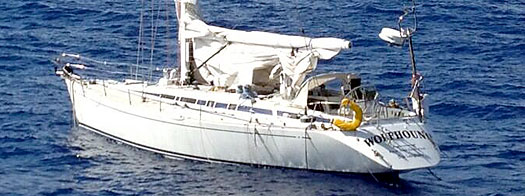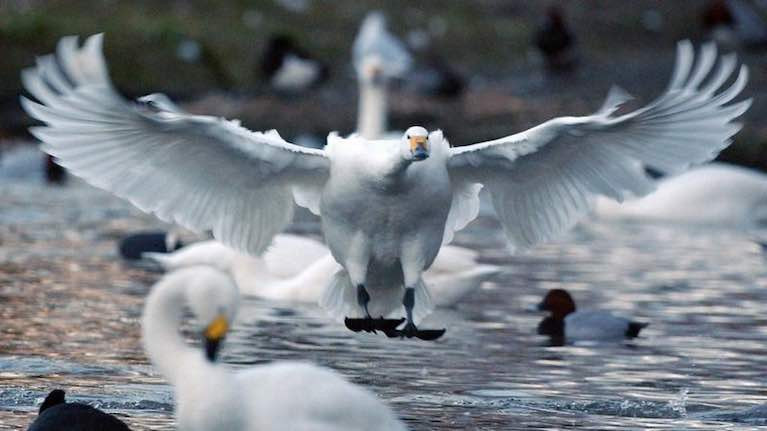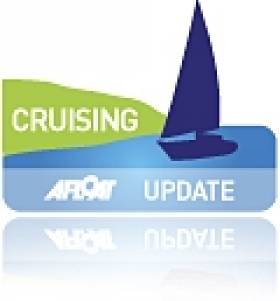Displaying items by tag: Swan
Environmental Groups Call for Tougher River Basin Management Plan After Damning EPA Water Quality Report
A network of 25 environmental organisations has called on the Government to come up with an “effective plan” to address Ireland’s “escalating water pollution crisis”.
The Sustainable Water Network (SWAN) was responding to the Environmental Protection Agency (EPA) water quality 2016-2021 report, which was published late last week.
The report indicates that nearly half of rivers and lakes and two-thirds of estuaries are not as healthy or resilient as they should be.
An Taisce has described the EPA report as “profoundly alarming” and a “red alert for the state of Irish waters”.
The report states that 46% of surface waters are unhealthy, and estuaries are declining by 16% while coastal waters are declining 10%.
 An Taisce natural environment officer Dr Elaine McGoff Photo: via Twitter
An Taisce natural environment officer Dr Elaine McGoff Photo: via Twitter
Nearly half of Irish rivers (43%), mostly in the south and southeast of the country, are below healthy levels for nitrogen, while nearly a third of rivers (30%) and a third of lakes (33%) are failing for phosphorus concentrations, SWAN notes.
“ Concentrations of nitrogen, in particular, has increased substantially across our rivers, and estuaries, with these declines, clearly coinciding with areas of increased intensive dairy farming,”it notes.
“Our water environment’s depleted state in turn lead to a loss of the wildlife that relies on a healthy water environment, such as our iconic salmon and much-loved kingfisher,” SWAN has said.
“This failure also has a negative impact on our own health: pollution regularly contaminates the water we source for drinking and that we swim in; while the waterscapes that have been so important for our wellbeing in the past three years are being allowed to languish and decline,”it says.
“The three-yearly EPA water quality report acts as a rigorous assessment of the government water management strategy,”SWAN says.
“The data published today clearly shows that this has failed to address the damaging impacts of agriculture, waste water, forestry, unregulated land drainage and river alterations. It therefore serves as both evidence and alarm-call that a change of approach is urgently needed,” it says.
SWAN says the government has a “golden opportunity” to fix this now, as it is currently finalising the 2022-2027 River Basin Management Plan.
“This is required under the EU Water Framework Directive to lay out how we will restore our inland and coastal waters to a healthy state by the mandatory deadline of 2027,”SWAN says.
“However, the plan in its draft form is much too weak, and is completely lacking in the ambition and targeted actions needed to tackle pollution,”it says.
An Taisce says agricultural activity, inadequate wastewater treatment, forestry processes, and activities such as land drainage and river alterations are the main causes of water quality decline.
“Concentrations of nutrients such as nitrogen and phosphorus are far too high in many of our water bodies,” it says.
“Nearly a third of rivers and lakes have elevated phosphorus concentrations, and an alarming 39% of river sites had increasing concentrations of nitrogen,”it says, noting nitrogen pollution is most prevalent in the south and south-east due to the high levels of intensive farming on freely draining soils.
“While there have been some improvements in certain areas on foot of community or individual action, individuals alone cannot solve the water quality crisis,”An Taisce says.
“ Governments must stand up and be counted, it simply isn’t possible for individuals to solve this crisis without robust government support. Urgent and transformative steps are now necessary to stem the tide of water pollution,”it says.
An Taisce natural environment officer Dr Elaine McGoff said that water protection measures “have failed time and time again”.
“The Government has long been aware that many of their policies for agricultural expansion, forestry planting and clearfelling, and land drainage are at odds with their stated ambition to improve water quality,” she says.
“This is compounded by their failure to adequately address the shambles that is our water treatment infrastructure,” she adds.
“It’s time for a different approach - an honest approach,” Dr McGoff says.
“We cannot keep doing the same thing and acting surprised when we get the same result. The Government now has an opportunity to take a different approach in drafting their new River Basin Management Plan which could, and should chart a way towards healthier waterways,” she says.
“This Government has demonstrated time and again where their priorities lie, and it’s not with the environment,” Dr McGoff says.
“ Will they once again plan to fail to protect water quality, and capitulate to the demands of agribusiness, the forest industry and other vested interests, or will they step up and protect water quality for the common good?” she asks.
Environmental Network Hits out at Government's "Hotch-Potch" Draft River Basin Management Plan
The Sustainable Water Network (SWAN) has hit out at the Government’s draft plan for managing Ireland’s inland and coastal waters.
The network of 25 environmental organisations says the River Basin Management Plan is “completely lacking in the strong ambition, measures and targets needed to restore our waters to good health”.
The plan - the third since 2009 – aims to reflect the requirements of the EU Water Framework Directive (WFD) in restoring all of Ireland’s waters to a healthy state by 2027 and to prevent any further deterioration.
“Despite this, only half Ireland’s rivers, lakes and estuaries are currently healthy,” SWAN says in a statement.
“ With river water quality in decline and water pollution now rising at an unprecedented rate, the network of 25 environmental organisations sees this as a water crisis that will persist under the proposed plan,”it says.
SWAN co-ordinator Sinéad O’Brien said that while there are “some welcome improvements in the draft plan”, its lack of ambition is “most disappointing”.
 River water quality is in decline and water pollution is rising at an unprecedented rate says SWAN
River water quality is in decline and water pollution is rising at an unprecedented rate says SWAN
“The plan as it stands is a hotch-potch of actions and aspirations that may, or may not, restore some of our water bodies to health,” she said.
“ In fact, under law we must restore all our waters by 2027, but this plan lacks the specific, targeted and time-bound measures that would provide a clear path to achieving this,” she said.
“One of our key recommendations is to introduce a prohibition on wetland drainage and to develop a national wetland restoration plan. This would not only restore our rivers, lakes, and improve water quality, it would also deliver immense benefits for climate, nature and flood resilience,” O’Brien said.
“Sewage is the main source of pollution in 208 waterbodies, yet the proposed plan doesn’t include measures to fix these by the 2027 deadline,”she noted.
“The fact that raw and poorly treated sewage is still being released into our rivers, lakes and seas is completely unacceptable. The plan should include a requirement that the Irish Water Investment Plan includes action to halt sewage pollution in these waters, as a priority,” O’Brien said.
An Taisce’s natural environmental officer Elaine McGoff said that agriculture policy “must be brought in line with the directive so as to halt and reverse escalating water pollution”.
“Risk assessments based on the directive requirements should be implemented for all intensive farms, including derogation farms. We also need directive-based assessments when giving licences for forestry and a ban on afforestation and re-planting on peat soils in acid-sensitive catchments, which is detrimental to water wildlife,” she said.
 Coastwatch coordinator Karin Dubsky
Coastwatch coordinator Karin Dubsky
Coastwatch coordinator Karin Dubsky noted that “only 38% of our estuaries are now officially ‘good’ status”.
“Healthy estuaries are vital for nature and coastal communities. We need to jump from disjointed promises and aspirations to integrated management, with clear actions to reach at least ‘good’ status in the plan,” Dubsky said.
“Those actions must be integrated across all national level coastal and marine policy, and legislation, including the new Maritime Area Planning Act and the National Marine Planning Framework.,” she said.
Streamscapes project director Mark Boyden said that “to ensure we restore our waters, we need the public and local river groups/trusts involved from the start in the development of action plans for their local waters”.
“They need to be facilitated and resourced to do this. We also need full transparency and access to water quality information,” Boyden said.
In a separate statement, An Taisce has called on the government "as a matter of urgency" to strengthen the proposed measures in the Nitrates Action Programme to safeguard Ireland’s water quality.
An Taisce has recommended a range of actions, and is calling on Ireland not to seek another Nitrates Derogation from the European Commission until sufficient safeguards for water in Ireland are proven to be in place.
The link to public consultation on the draft river basin management plan, which runs until March 31st, is here
Dead Swan on Lough Beg Found to Have Bird Flu
The BBC has reported that a wild swan found dead earlier this week at Lough Beg near Toomebridge, a small village on the North West corner of Lough Neagh has tested positive for Bird Flu. Lough Beg is a small freshwater lake on the border between County Londonderry and County Antrim.
The Lower River Bann flows into it from Lough Neagh at the southern end and continues its route to the sea from the northern end. It has been designated a Ramsar Site which is a wetland site designated to be of international importance under the Ramsar Convention.
Preliminary results confirmed that the swan had a similar strain of the disease to that found in poultry flocks and wild birds in Britain. Public health officials have advised that the risk to public health from this strain of avian influenza is very low, as is the threat to food safety. A dead falcon found in County Limerick also tested positive in recent days.
The chief vet Dr Robert Huey urged poultry keepers to tighten their biosecurity measures to stop transmission to commercial flocks.
The swan was found by environmentalist Chris Murphy who was assessing the impact of A6 roadworks on overwintering birds at the lough - an internationally important protected site. Further tests will now be carried out to establish whether the disease is a highly pathogenic strain or one which is less virulent.
On Wednesday a bird flu prevention zone was declared across Britain after the discovery of the disease there. Where it is detected in poultry flocks, the birds are destroyed, and prevention zones are established around affected premises. It can also lead to restrictions on trade.
Northern Ireland's Chief Vet Robert Huey urged anyone with poultry to tighten their biosecurity to prevent interaction between wild birds and their flocks.
#wolfhound – You can't put a good boat down. Here she is. The lost one. The Irish Swan 48 Wolfhound, doing better on her own than she did with a crew writes W M Nixon.
Nine weeks after she was abandoned in a storm 70 miles north of Bermuda, her crew taken off safely by the Greek ship Tetien Trader, Wolfhound floats on all alone, now 800 miles southeast of Bermuda.
Afloat.ie reader Martin Butler sent the unique photo at the weekend confounding early news reports the craft had sunk.
Going her own way, she's getting near the wide Sargasso Sea, where she might drift for eternity unless somebody brings her in. Highly likely, now that this remarkable pic has gone viral. All things considered, she's looking very well. Her upper boot-top is still showing, so there can't be that much water down below. But we can't tell if her hull is still intact, as she was starboard-side-on for the rescue. So there could well be impact damage away from the camera's eye.
Miraculously, her tall carbon mast is still standing, even though the forestay has broken from the stemhead - you can see it wrapped round the shrouds. And the backstay has also gone, so only the checkstay is holding the rig fore-and-ft. If the checkstay goes, then the mast is likely to break, with the risk of its splintered pieces holing the hull. Meanwhile her mainsail, lying as it was dropped, seems all of a piece. She's a tough old bird. Whoever can get the mostest there the fastest is going to get one very gallant boat. She may be plastic, but Wolfhound has a heart of oak.

Her upper boot-top is still showing, so there can't be that much water down below
And how can she be found again, now that the ship that took the pic has moved on? Let's hope that somebody thought to chuck a mobile phone into her cockpit. It could give a signal, however weak, for a long time - long enough to find her again and put a crew aboard to sail her up to Bermuda, or across to the Azores
Read WM Nixon's full account of the rescue of Wolfhound's crew out now in the Spring issue of Afloat at all good news agents nationwide






























































